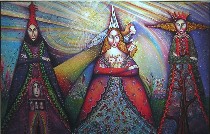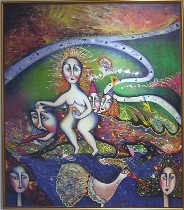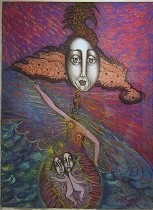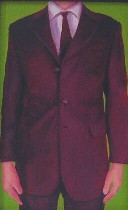 Cartoons and fantasy painting, although currently a hot art fashion, has always been a thread in artmaking. Whereas a lot of the young painters making this kind of work have been heavily influenced by Japanese manga, R. Crumb and the underground comics scene, and Dell comics superheroes and monsters, cartooning and fantasy come in many colors.
Cartoons and fantasy painting, although currently a hot art fashion, has always been a thread in artmaking. Whereas a lot of the young painters making this kind of work have been heavily influenced by Japanese manga, R. Crumb and the underground comics scene, and Dell comics superheroes and monsters, cartooning and fantasy come in many colors.
Rochelle Dinkins, who has work hanging at ArtForms Gallery, however, is not young. She has been painting heavily patterned narrative cartoon fantasies for years. And the work has less to do with manga, underground comics or superheroes, and more to do with fairytale illustrations of princesses and castles, and with archetypal themes of birth, resurrection, personal relationships amidst exterior and interior forces like love, hate and death. But everything gets filtered through a romantic, ’60s flower-child kind of patterning and and sweetness (left top, “Magic Vessels,” oil on linen, 44″ x 68″).
 All of Dinkins women look pretty much alike. But there’s no hipster and street-cred attytood here, no energetic sense of action, like you might find in a Layla Ali cartoon, for example. Dinkins’ women have faces like the queens in a deck of playing cards; the patterning and costumes also call playing cards to mind; and the figures have a posed, unmoving feeling, as if they are static representations of an attitude or status. The paintings, while giving the impression of sources from an earlier period than most of the cartoons we are seeing now, do not feel dated, but rather personal and outsider-y (right, “Departure,” oil on linen, 45″ x 38″).
All of Dinkins women look pretty much alike. But there’s no hipster and street-cred attytood here, no energetic sense of action, like you might find in a Layla Ali cartoon, for example. Dinkins’ women have faces like the queens in a deck of playing cards; the patterning and costumes also call playing cards to mind; and the figures have a posed, unmoving feeling, as if they are static representations of an attitude or status. The paintings, while giving the impression of sources from an earlier period than most of the cartoons we are seeing now, do not feel dated, but rather personal and outsider-y (right, “Departure,” oil on linen, 45″ x 38″).
They are feminine cartoons, from a woman’s point of view of life among the women in kitchen or the oda or some other domestic, female compound. Male presences are small. Even the heraldic monsters seem to come from a feminine, or at least child-like, viewpoint. The paintings as well as drawings are narrative, and remind me of the Unicorn Tapestries in their reference to some medieval yet made-up time and place, and in their use of close-to-the-picture-plane space. And they are mysterious. Why does this pregnant woman have two adults–one male, one female–nested in her womb? I can make up a million stories about this, and probably none of them would be the artist’s story (left, “Mama and her Treasures,” on paper, 29″ x 21″).
 The paintings, with their beautiful patterning and undeveloped space made me think of a sane Adolf Wolfli illustrating Grimm’s Fairtales. But unlike Wolfli, say, or Hundertwasser, other people exist here as significant and as subjects, the pattern a milieu for the people rather than whatever people there might be reduced to mere pattern.
The paintings, with their beautiful patterning and undeveloped space made me think of a sane Adolf Wolfli illustrating Grimm’s Fairtales. But unlike Wolfli, say, or Hundertwasser, other people exist here as significant and as subjects, the pattern a milieu for the people rather than whatever people there might be reduced to mere pattern.
The work is definitely not in the mainstream. But it’s signature work of a specific artist. Dinkins, by the way, had a Fleisher Challenge about 15 years ago. I’m glad to see her work again.
 In the back room, paintings by Robert Minervini take a deadpan, stiff-figured approach to bodies covered with suits or plastic. The work, which is not yet fully developed, communicates constriction and weirdness, and I’m interested in seeing where it goes (right, “Money Green”).
In the back room, paintings by Robert Minervini take a deadpan, stiff-figured approach to bodies covered with suits or plastic. The work, which is not yet fully developed, communicates constriction and weirdness, and I’m interested in seeing where it goes (right, “Money Green”).









